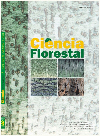
|
Ciência Florestal
Centro de Pesquisas Florestais - CEPEF, Departamento de Ciências Florestais - DCFL, Programa de Pós Graduação em Engenharia Florestal - PPGEF
ISSN: 0103-9954
EISSN: 0103-9954
Vol. 25, No. 1, 2015, pp. 23-26
|
 Bioline Code: cf15003
Bioline Code: cf15003
Full paper language: Portuguese
Document type: Research Article
Document available free of charge
|
|
|
Ciência Florestal, Vol. 25, No. 1, 2015, pp. 23-26
| en |
DYNAMICS OF VEGETATION IN AN ATLANTIC FOREST FRAGMENT IN NORTHEASTERN BRAZIL
de Carvalho Rabelo, Felipe Rodrigo; Rodal, Maria Jesus Nogueira; Lins e Silva, Ana Carolina Borges & de Lima, André Luiz Alves
Abstract
To test the hypothesis that the physiognomy, structure and dynamics of woody species are influenced by
the spatial gradient edge-interior, data were collected from these parameters in 2004, 2007 and 2010 in an
Atlantic forest fragment. Species were sampled for the Canopy (DS), with circumference > 15 cm to 1.3 m soil
and understory (SB) in circumference between ground level> 3 cm and CAP <15 cm on edge-gradient
formed within 35 years. In 2004, we assessed three positions in the fragment: edge, intermediate and inner
(> 150 m from the forest boundary), and analyzed 1,000 m² per site, divided into plots of 10 m², to measure
individuals of higher class. In each plot a sub-plot of 5 m² for sampling understory was installed. Branches
were collected from three adult individuals from the species to obtain the density of the wood. The number
of individuals (NI), basal area (BA), mortality (TM), recruitment rate (TR), periodic annual diameter
increment (IPA), loss rate (P) and gain rate (G) Area and basal turnover rates in number of individuals (TN)
and basal area (TA) class tree component in the three locations showed no significant edge effect. At the
edge, the understory had lower values of NI and AB and higher TM than in the forest interior. Differences
between the strata occur regardless of edge sealing, since young plants present in most individuals in the
sample class SB, which are more sensitive than adult trees to changes caused by the creation of the edge.
Rates of loss and gain of AB and AB turnover in NI and in SB presented higher values than on the DS,
which points to a stratum with larger changes. In DS there were no differences in species richness among
environments differs from that observed in SB. The floristic composition of the DS in environments closer
to the forest limit was quite distinct from that of the interior, indicating that there has been no recovery of
floristic composition. All environments SB had low similarity. The edges of the DS and SB had a higher
concentration of individuals in class intervals smaller density values timber. The DS has already recovered
biomass, although the edge and intermediate environments have not recovered species composition late.
The SB still suffers the edge effect. Possibly, the highest concentration of individuals is in class with lower
density wood result on edge.
Keywords
species composition; phytosociology; demographic rates and turnover
|
| |
| pt |
DINÂMICA DA VEGETAÇÃO EM UM FRAGMENTO DE MATA ATLÂNTICA NO NORDESTE DO BRASIL
de Carvalho Rabelo, Felipe Rodrigo; Rodal, Maria Jesus Nogueira; Lins e Silva, Ana Carolina Borges & de Lima, André Luiz Alves
Resumo
Para testar a hipótese que a fisionomia, estrutura e dinâmica de espécies lenhosas são influenciadas pelo
gradiente espacial borda-interior, foram coletados dados desses parâmetros em 2004, 2007 e 2010 em um
fragmento de Floresta Atlântica. Foram amostradas para o Dossel (DS), plantas com circunferência do
caule a altura do peito (CAP) > 15 cm e do sub-bosque (SB) com circunferência ao nível do solo entre >
3 cm e CAP < 15 cm em um gradiente borda-interior formado há 35 anos. Em 2004, foram avaliadas três
posições no fragmento: borda, intermediária e interior (> 150 m do limite florestal), sendo analisados 1000
m² por local, divididos em parcelas de 10 m², para medir os indivíduos de maior classe. Em cada parcela
foi instalada uma subparcela de 5 m² para amostragem do sub-bosque. Foram recolhidos ramos de três
indivíduos adultos das espécies, para obtenção da densidade da madeira. O número de indivíduos (NI), área
basal (AB), taxa de mortalidade (TM), taxa de recrutamento (TR), incremento periódico anual em diâmetro
(IPA), taxa de perda (P) e ganho (G) de área basal e as taxas de rotatividade em número de indivíduos (TN)
e em área basal (TA) da classe do componente arbóreo nos três locais evidenciaram não haver efeito de
borda significativo. Na borda, o sub-bosque teve menores valores de NI e AB e maiores TM, que no interior
do fragmento. Diferenças entre os estratos acontecem, independentemente do selamento da borda, já que
plantas jovens na maior classe amostral apresentam indivíduos no SB, que são mais sensíveis que as árvores
adultas às mudanças causadas pela criação da borda. Taxas de perda e ganho de AB e de rotatividade em NI e
AB, no SB, apresentaram valores maiores que no DS, o que aponta para um estrato com maiores mudanças.
No DS não ocorreram diferenças de riqueza de espécies entre os ambientes, distinto do observado no SB.
A composição florística no DS nos ambientes mais próximos ao limite florestal foi bastante distinta que a
do interior, indicando que ainda não houve recuperação da composição florística. Todos os ambientes do
SB tiveram baixa similaridade. As bordas do DS e SB apresentaram maior concentração de indivíduos em
intervalos de classe de menores valores de densidade de madeira. O DS já recuperou a biomassa, embora os
ambientes de borda e intermediário não tenham recuperado a composição de espécies tardias. O SB ainda
sofre efeito de borda. Possivelmente, a maior concentração de indivíduos em classe de menor densidade da
madeira sendo resultado na borda.
Palavras-chave
composição de espécie; fitossociologia; taxas demográficas e de rotatividade
|
| |
© Copyright 2015 - Ciência Florestal
Alternative site location: http://cascavel.ufsm.br/revistas/ojs-2.2.2/index.php/cienciaflorestal/index
|
|
